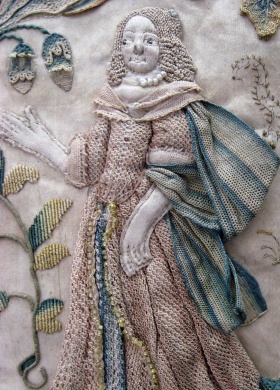Many samplers and diagrams of embroidery stitches in colour.
Detail photos of historic embroideries of the Iklé collection, St.Gallen, Switzerland.

| ANNE WANNER'S Textiles in History / Vocabulary Project |
| The second booklet
of the Vocabulary Project is out of print: |
for any questions, please
send an e-mail to wanner@datacomm.ch |
S
C H L I N G S T I C H |
P O I N T . D E . F E S T O
N P O I N T . D E . C H A Î N E T T E P O I N T . D E . N O E U D ________________________ |
L
O O P E D . S T I T C H E S |
P U N T I . A . C A P P I O P U N T O . C A T E N E L L A P U N T O . N O D O |
| Booklet of 22
pages, in 4 languages (German, English, French
and Italian) Many samplers and diagrams of embroidery stitches in colour. Detail photos of historic embroideries of the Iklé collection, St.Gallen, Switzerland. |
 |
| Author: Anne
Wanner-JeanRichard; Stumpwork by Ursula Karbacher. Diagrams: Margarete Müller-Schulten. Layout, photos, scans, embroidered stitches: Anne Wanner-JeanRichard. Translation: Elizabeth Fischer (English and French), Thessy Schoenholzer (Italian). Consulting: Ute Bargmann (Conway, MA, USA), Mary Schoefer (Lyon, F), Uta-Christiane Bergemann (Bochum, D), Marianne Flügel (Köln, D). Editor: Textilmuseum St.Gallen, Switzerland, © Textilmuseum St.Gallen, Anne Wanner-JeanRichard. ISBN 978-3-033-02451-9, Photonachweis Textilmuseum St.Gallen Niedermann Druck AG, St.Gallen, 2010 |
Acknowledgements My gratitude goes to the Iklé-Frischknecht Foundation for its financial support of the project. The textile examples from the Iklé-Jacoby collection were made available thanks to Hanspeter Schmid, director of the St. Gallen Textile Museum, Ursula Karbacher, curator and Janina Hauser, textile conservator. I am indebted to my husband Rene Wanner for expert advice and technical assistance on digital presentation. Thanks are also due to all CIETA colleagues who encouraged this endeavour through our many discussions during conferences and meetings. |
The
project of a glossary of embroidery stitches arose
among the members of the „Embroidery Group“,
one of the specialized groups under the banner of the
CIETA (Centre International d’Etude des Textiles
Anciens, based in Lyon). |
In her book The Primary Structures of Fabrics (1980, p. 241), Irene Emery defines looped stitches as satin stitches that do not follow a straight line. Loops are created by holding the thread down while bringing the needle back out and over the thread. The basic forms of looped stitch are the blanket stitch and its close relative, the feather stitch. The same definition applies to the closed chain stitch. If the thread is wound once or more times around the needlepoint, knotted stitches are formed. For the fundamentals of embroidery we relied on the works of Charles Germain de St. Aubin, Thérčse de Dillmont, Mary Thomas, Ruth Grönwoldt. Noémi Speiser’s descriptions were particularly helpful, as well as the treatises by Renée Boser/Irmgard Müller and by Annemarie Seiler-Baldinger. |
 |
front |
reverse |
|
 |
 |
 Einfacher Kettenstich Chain Stitch |
 |
 Leiterstich, breiter Kettenstich Open Chain Stitch, Roman Chain Stitch |
 |
|
 Swiss linen embroidery, 16th c., reverse St. Gallen Textilmuseum Inv. 47673 |
|
 Detail of sampler, Hamburg 1825, front St. Gallen Textilmuseum Inv. 20224 |
|
 Detail of stumpwork embroidery, England, middle of 17th c., St. Gallen Textilmuseum Inv. 32235 In the booklet there are some examples of English Stumpwork Embroidery and therefore a short description of this kind of regional embroidery is added. The text is the following: |
| "Stumpwork"
- English relief embroidery (Text by Ursula Karbacher Curator Textilmuseum St.Gallen) In England, after the Reformation, embroidery was often seen as a sign of devotion in women. For the Puritan mind, a schoolgirl’s sampler symbolised her virtue and piety. The padded embroidery techniques, which were traditionally taught to young girls as early as 1630 and up to the end of the 17th century, seem to have been particular favourites. The scenes illustrated were taken from the Old Testament and classical mythology, such as Adam and Eve, the sacrifice of Isaac, the judgement of Paris or Ovid’s metamorphoses. Depictions of King Charles the First and his wife Queen Henrietta Maria were very popular, as they were a way for the embroiderer to represent herself and her beloved. These minutely stitched pieces of handiwork have come down to us as pictures, frames, book covers and motifs embossing jewellery boxes or beauty cases. |
They are stuffed with cotton, flax, tow or wood chips. Hands and faces are sometimes modelled out of wax and bone. The embroideries are also decorated with pearls, gold thread, bits of glass, or even real hair, and may include crocheted or knitted pieces. The scenes and characters are lovingly set in lavish bowers filled with exotic flowers and surrounded by playful pets and wild animals. The name „Stumpwork“ was given to this style of embroidery in the 19th century. Its origin is unclear and subject to various interpretations. Maybe it refers to the meaning of “clumsy“ that the term “stump” implies. After all, in 1913, this technique was disparaged as a hideous travesty of relief sculpture. Today, these works strike us by their unique naiveté, charm and sincerity. They seem to still echo the hopes and dreams about love and life, harboured by the young girls who worked on them with such skill and patience. |
| home | Last revised January, 2011 |